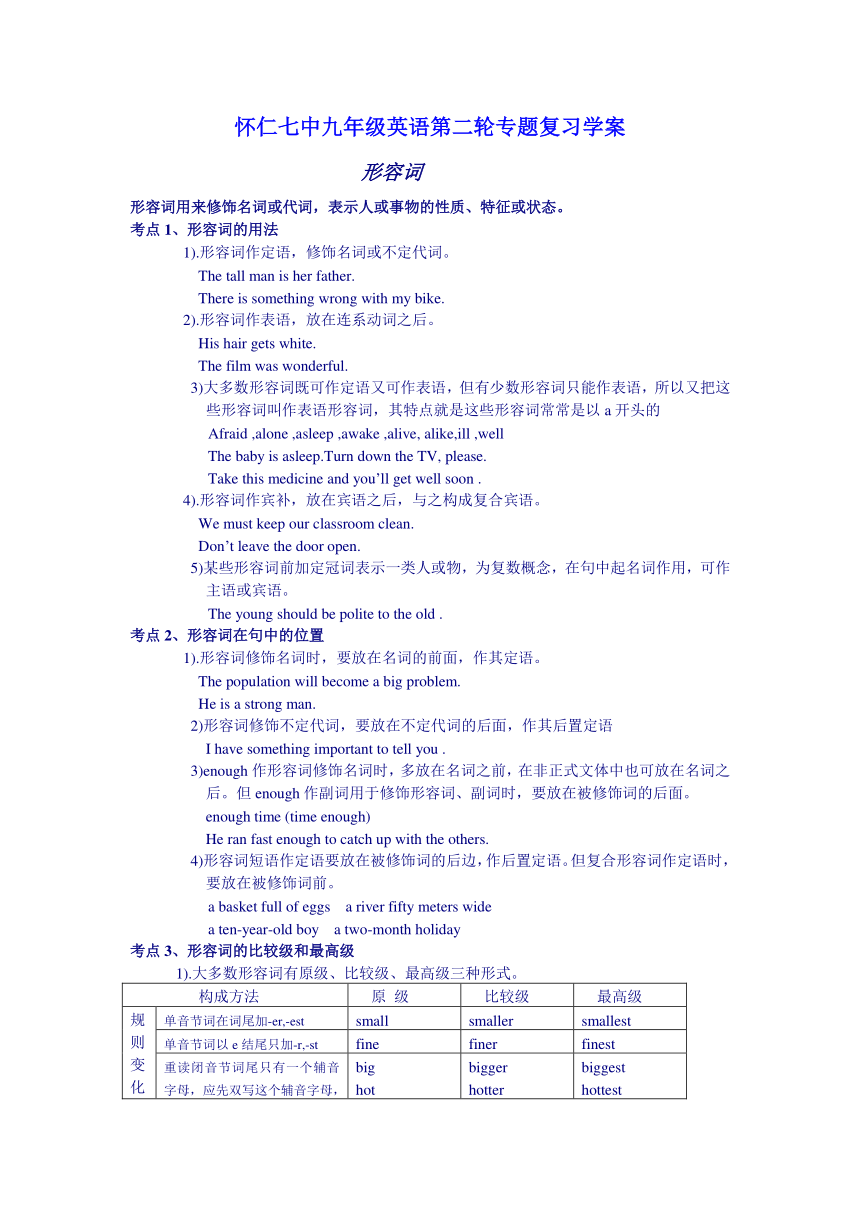怀仁七中九年级英语第二轮专题复习学案 形容词
文档属性
| 名称 | 怀仁七中九年级英语第二轮专题复习学案 形容词 |  | |
| 格式 | zip | ||
| 文件大小 | 17.5KB | ||
| 资源类型 | 教案 | ||
| 版本资源 | 通用版 | ||
| 科目 | 英语 | ||
| 更新时间 | 2014-03-12 18:03:26 | ||
图片预览

文档简介
怀仁七中九年级英语第二轮专题复习学案
形容词
形容词用来修饰名词或代词,表示人或事物的性质、特征或状态。
考点1、形容词的用法
1).形容词作定语,修饰名词或不定代词。
The tall man is her father.
There is something wrong with my bike.
2).形容词作表语,放在连系动词之后。
His hair gets white.
The film was wonderful.
3)大多数形容词既可作定语又可作表语,但有少数形容词只能作表语,所以又把这些形容词叫作表语形容词,其特点就是这些形容词常常是以a开头的
Afraid ,alone ,asleep ,awake ,alive, alike,ill ,well
The baby is asleep.Turn down the TV, please.
Take this medicine and you’ll get well soon .
4).形容词作宾补,放在宾语之后,与之构成复合宾语。
We must keep our classroom clean.
Don’t leave the door open.
5)某些形容词前加定冠词表示一类人或物,为复数概念,在句中起名词作用,可作主语或宾语。
The young should be polite to the old .
考点2、形容词在句中的位置
1).形容词修饰名词时,要放在名词的前面,作其定语。
The population will become a big problem.
He is a strong man.
2)形容词修饰不定代词,要放在不定代词的后面,作其后置定语
I have something important to tell you .
3)enough作形容词修饰名词时,多放在名词之前,在非正式文体中也可放在名词之后。但enough作副词用于修饰形容词、副词时,要放在被修饰词的后面。
enough time (time enough)
He ran fast enough to catch up with the others.
4)形容词短语作定语要放在被修饰词的后边,作后置定语。但复合形容词作定语时,要放在被修饰词前。
a basket full of eggs a river fifty meters wide
a ten-year-old boy a two-month holiday
考点3、形容词的比较级和最高级
1).大多数形容词有原级、比较级、最高级三种形式。
构成方法 原 级 比较级 最高级
规则变化 单音节词在词尾加-er,-est small smaller smallest
单音节词以e结尾只加-r,-st fine finer finest
重读闭音节词尾只有一个辅音字母,应先双写这个辅音字母,再加-er,-est bighot biggerhotter biggesthottest
以“辅音字母+y” 结尾的双音节词,先变y为i,再加-er,-est Happyeasy Happiereasier Happiest
规则变化 以-er,-ow结尾的双音节词,在末尾加-er,-est clevernarrow cleverernarrower cleverestnarrowest
其他双音节词和多音节词,在原级前加moer,most deliciouscareful more deliciousmore careful most deliciousmost careful
不规则变化 good/wellbad/illmany/muchlittlefarold betterworsemorelessfarther/furtherolder/elder bestworstmostleastfarthest/furthestoldest/eldest
2).形容词比较等级的用法
形容词比较等级分为原级、比较级、最高级三种形式。现将其经典用法归纳如下:
(1)、原级的用法
①句中只出现了一个人或物,没有比较对象时,要用原级。
She has a new computer.
②表示A和B两者比较,程度相同。用句型:
A+系动词+as+形容词原级+as+B
Tom is as honest as John.
③表示A和B两者比较,A在程度上不如B时,用句型:
A+系动词+not+as/so+形容词原级+as+B
The weather in Beijing is not as/so hot as that in Wuhan.
需注意的原级的用法:
①表示倍数的句型:A+系动词+数词(times)+as +形容词原级+as +B
This garden is ten times as large as that one.
② as…as possible(表示“尽可能……”)
Please hand in your homework as soon as possible.
(2)、比较级的用法
两者比较,用比较级。其句型为:
A+系动词+形容词的比较级+than+B
需注意的比较级的用法:
①在比较级前面还可用much,even,still,a little等词语来修饰,表示“…...的多”“甚至…….”“更…….. ”“ ……..一些”
②表示倍数:A+系动词+数词(times)+形容词的比较级+than+B
Our room is twice larger than theirs.
③表示“大……岁”时用“表示数量的词+比较级”来表示。
I’m two years older than you .
④“比较级+than any other+单数名词”表示“比其他的任何……都……”
⑤“比较级+and+比较级”表示“越来越……”
China is becoming more and more beautiful.
⑥“the+比较级,the+比较级 ”译为“越…….就越”
The busier he is , the happier he feels.
⑦“the+比较级+of the two” 译为“两个中比较……的”
He is the better of the two.
⑧“Which(who) is +比较级,A or B ”译为“A和B哪一个更……?
Which one is more popular,the radio or the movie
(3)、最高级的用法
表示三者或三者以上(人或物)的比较,其中有一个在某一方面超过其他两个或几个时,用最高级。常用句型:A+系动词+ the+形容词最高级+ of/in
of the four of all of all the boys of us
in China , in the world in our school in my family
注意:当用介词短语表示形容词最高级的比较范围时,介词后的名词或代词与句中的主语是同一类事物,并把主语包括在内时,介词用of ,当只说明是在某一空间范围内的比较时,介词用in。
需注意的比较级的用法:
① one of the+最高级+复数名词,表示“最…….之一”。
Shanghai is one of the most beautiful cities in China.
② Which(Who) is +the +最高级, A , B or C 意指三个或三个以上的事物或人中“哪一个(谁)最…….?”
③我们可以用原级、比较级、最高级三种方式分别来表示最高级
No other student in her class is as good as she
She is better than any other student in her class.
She is the best student in her class.
形容词
形容词用来修饰名词或代词,表示人或事物的性质、特征或状态。
考点1、形容词的用法
1).形容词作定语,修饰名词或不定代词。
The tall man is her father.
There is something wrong with my bike.
2).形容词作表语,放在连系动词之后。
His hair gets white.
The film was wonderful.
3)大多数形容词既可作定语又可作表语,但有少数形容词只能作表语,所以又把这些形容词叫作表语形容词,其特点就是这些形容词常常是以a开头的
Afraid ,alone ,asleep ,awake ,alive, alike,ill ,well
The baby is asleep.Turn down the TV, please.
Take this medicine and you’ll get well soon .
4).形容词作宾补,放在宾语之后,与之构成复合宾语。
We must keep our classroom clean.
Don’t leave the door open.
5)某些形容词前加定冠词表示一类人或物,为复数概念,在句中起名词作用,可作主语或宾语。
The young should be polite to the old .
考点2、形容词在句中的位置
1).形容词修饰名词时,要放在名词的前面,作其定语。
The population will become a big problem.
He is a strong man.
2)形容词修饰不定代词,要放在不定代词的后面,作其后置定语
I have something important to tell you .
3)enough作形容词修饰名词时,多放在名词之前,在非正式文体中也可放在名词之后。但enough作副词用于修饰形容词、副词时,要放在被修饰词的后面。
enough time (time enough)
He ran fast enough to catch up with the others.
4)形容词短语作定语要放在被修饰词的后边,作后置定语。但复合形容词作定语时,要放在被修饰词前。
a basket full of eggs a river fifty meters wide
a ten-year-old boy a two-month holiday
考点3、形容词的比较级和最高级
1).大多数形容词有原级、比较级、最高级三种形式。
构成方法 原 级 比较级 最高级
规则变化 单音节词在词尾加-er,-est small smaller smallest
单音节词以e结尾只加-r,-st fine finer finest
重读闭音节词尾只有一个辅音字母,应先双写这个辅音字母,再加-er,-est bighot biggerhotter biggesthottest
以“辅音字母+y” 结尾的双音节词,先变y为i,再加-er,-est Happyeasy Happiereasier Happiest
规则变化 以-er,-ow结尾的双音节词,在末尾加-er,-est clevernarrow cleverernarrower cleverestnarrowest
其他双音节词和多音节词,在原级前加moer,most deliciouscareful more deliciousmore careful most deliciousmost careful
不规则变化 good/wellbad/illmany/muchlittlefarold betterworsemorelessfarther/furtherolder/elder bestworstmostleastfarthest/furthestoldest/eldest
2).形容词比较等级的用法
形容词比较等级分为原级、比较级、最高级三种形式。现将其经典用法归纳如下:
(1)、原级的用法
①句中只出现了一个人或物,没有比较对象时,要用原级。
She has a new computer.
②表示A和B两者比较,程度相同。用句型:
A+系动词+as+形容词原级+as+B
Tom is as honest as John.
③表示A和B两者比较,A在程度上不如B时,用句型:
A+系动词+not+as/so+形容词原级+as+B
The weather in Beijing is not as/so hot as that in Wuhan.
需注意的原级的用法:
①表示倍数的句型:A+系动词+数词(times)+as +形容词原级+as +B
This garden is ten times as large as that one.
② as…as possible(表示“尽可能……”)
Please hand in your homework as soon as possible.
(2)、比较级的用法
两者比较,用比较级。其句型为:
A+系动词+形容词的比较级+than+B
需注意的比较级的用法:
①在比较级前面还可用much,even,still,a little等词语来修饰,表示“…...的多”“甚至…….”“更…….. ”“ ……..一些”
②表示倍数:A+系动词+数词(times)+形容词的比较级+than+B
Our room is twice larger than theirs.
③表示“大……岁”时用“表示数量的词+比较级”来表示。
I’m two years older than you .
④“比较级+than any other+单数名词”表示“比其他的任何……都……”
⑤“比较级+and+比较级”表示“越来越……”
China is becoming more and more beautiful.
⑥“the+比较级,the+比较级 ”译为“越…….就越”
The busier he is , the happier he feels.
⑦“the+比较级+of the two” 译为“两个中比较……的”
He is the better of the two.
⑧“Which(who) is +比较级,A or B ”译为“A和B哪一个更……?
Which one is more popular,the radio or the movie
(3)、最高级的用法
表示三者或三者以上(人或物)的比较,其中有一个在某一方面超过其他两个或几个时,用最高级。常用句型:A+系动词+ the+形容词最高级+ of/in
of the four of all of all the boys of us
in China , in the world in our school in my family
注意:当用介词短语表示形容词最高级的比较范围时,介词后的名词或代词与句中的主语是同一类事物,并把主语包括在内时,介词用of ,当只说明是在某一空间范围内的比较时,介词用in。
需注意的比较级的用法:
① one of the+最高级+复数名词,表示“最…….之一”。
Shanghai is one of the most beautiful cities in China.
② Which(Who) is +the +最高级, A , B or C 意指三个或三个以上的事物或人中“哪一个(谁)最…….?”
③我们可以用原级、比较级、最高级三种方式分别来表示最高级
No other student in her class is as good as she
She is better than any other student in her class.
She is the best student in her class.
同课章节目录
- 词法
- 名词
- 动词和动词短语
- 动词语态
- 动词时态
- 助动词和情态动词
- 非谓语动词
- 冠词
- 代词
- 数词和量词
- 形容词副词及其比较等级
- 介词和介词短语
- 连词和感叹词
- 构词法
- 相似、相近词比较
- 句法
- 陈述句
- 一般疑问句和否定疑问句
- 特殊疑问句及选择疑问句
- 反意疑问句
- 存在句(There be句型)
- 宾语从句
- 定语从句
- 状语从句
- 主谓一致问题
- 简单句
- 并列句
- 复合句
- 主谓一致
- 主、表语从句
- 名词性从句
- 直接引语和间接引语
- 虚拟语气
- 感叹句
- 强调句
- 倒装句
- 祈使句
- 句子的成分
- 句子的分类
- 题型专区
- 单项选择部分
- 易错题
- 完形填空
- 阅读理解
- 词汇练习
- 听说训练
- 句型转换
- 补全对话
- 短文改错
- 翻译
- 书面表达
- 任务型阅读
- 语法填空
- 其他资料
